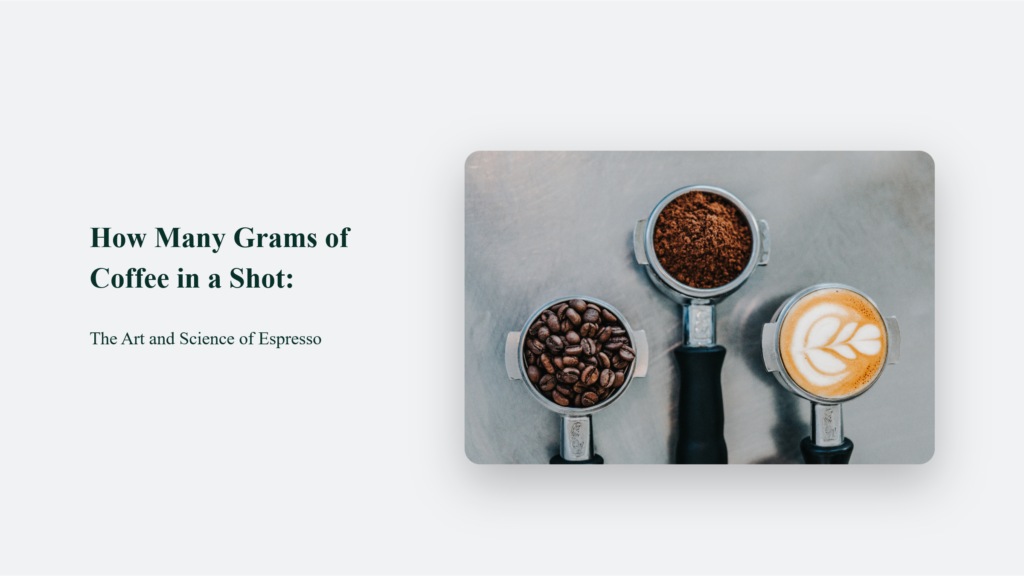Ah, espresso – that tiny, mighty hero of the coffee world. You’ve probably stood in line at a café, eagerly awaiting that rich, intense shot of caffeine. But have you ever wondered just How Many Grams of Coffee in a Shot? Well, buckle up because we’re about to dive deep into the heart of espresso territory.

How Many Grams of Coffee in a Shot: The Basics
A shot of espresso is typically one fluid ounce, with a double shot doubling that (obviously). It is about 30 mL for the single and 60 mL for the double. But things get a bit more granular (pun intended) when it comes to the coffee itself.
The consensus among coffee experts is that a single shot of espresso requires 7 to 9 grams of coffee grounds. This magic range turns a handful of beans into that dark, delicious elixir. Opt for a double shot; you’re looking at 18 to 21 grams. It’s a delicate balance – too little coffee, and you might as well be drinking dirty water; too much could choke your espresso machine into a bitter defeat.
The Art of Measurement
When pulling the perfect shot of espresso, precision is key. Clive Coffee suggests a brew ratio of 20g of ground coffee to 30g of liquid espresso for their signature recipe. The goal here is to strike a balance between strength, dose, yield, and brew time. Aiming for your shot to pull between 25 and 30 seconds is a good rule of thumb.
Size Matters
When it comes to espresso, size really does matter, and it’s not just a matter of how big your caffeine kick will be. The world of espresso shots is a universe of precise measurements, ratios, and a touch of barista wizardry.
First off, let’s talk about the single shot. This little guy typically involves about 7 to 9 grams of coffee, resulting in a 30 mL espresso shot. But hold on, it’s not just about the volume here. Due to the delightful crema (that frothy layer on top of your espresso), the actual volume minus the crema is about 15-20 mL. So, when you’re sipping on a single shot, think of it as a concentrated flavour bomb in a tiny package.
Let’s double the fun with a double shot or a “doppio” if you want to sound fancy at your local café. A double shot uses about 14 to 18 grams of coffee, giving you about 60 mL of espresso, or 30-35 grams when measured by mass. It is interesting that the double shot became the standard in America and many other parts of the world, thanks to a big-name coffee chain in the 1990s. So when you order a single shot, your barista might pull a double and split it. Sneaky but efficient.
In the specialty coffee world, they almost always use double baskets for the portafilters because single baskets don’t do the job regarding proper extraction. It is like choosing the right sword for a duel – the wrong size, and you’re just swishing around a toothpick.
And then there’s the art of dosing. It’s not just about piling coffee into the portafilter like you’re loading a cannon. The type of roast, the grind size, and even how you tamp it down (pressing the coffee grounds) can turn your shot from ‘meh’ to ‘magnificent.’
If you go for a larger dose, you’re looking at a stronger, sweeter, more concentrated flavour. But if you’re more of an “I like my coffee like I like my jokes – light and not too strong” person, a smaller dose will give you a milder taste.
So, whether you’re a single-shot sipper or a double-shot daredevil, remember, it’s all about finding that perfect balance for your taste buds. Like in life, sometimes you need a little, sometimes you need a lot, and sometimes you need a second shot to get things right.
The Coffee-Crema Tango
Espresso has a signature ingredient – crema. This creamy, aromatic layer is a game-changer. It’s added to the espresso and vice versa, and the balance between the coffee and crema can significantly affect the taste.
Espresso, Unpacked
Brewing espresso is an art and a science. Every step, from cleaning your portafilter to tamping and brewing, must be precise. The ideal brewing time for a single shot is around 20 seconds, while a double shot might take about 25 to 33 seconds.
Espresso and Caffeine: A Buzzing Relationship
Each shot of espresso contains about 75mg of caffeine. It might vary, but it’s a good average to keep in mind. When you compare it to regular coffee, remember that espresso packs more caffeine per ounce, but since we typically drink more than an ounce of coffee at a time, a standard cup of coffee ends up containing total caffeine.
Crafting Your Own Espresso
The beauty of making espresso at home is your control over the process. Experimenting with different amounts, brew times, and techniques can lead you to discover your perfect espresso recipe. It’s a journey filled with trials, errors, and, most importantly, delicious coffee.
Frequently Asked Questions:
How many grams of coffee are in a single espresso shot?
About 7 to 9 grams.
What about a double shot?
It’s typically 18 to 21 grams
How long should I brew my espresso?
Aim for 20 to 30 seconds.
In Conclusion: Your Espresso, Your Rules
While guidelines and recommended measurements exist, the perfect espresso shot is subjective. It’s about finding the balance that suits your taste. So, be your own barista, and play around with those grams until you strike gold.




